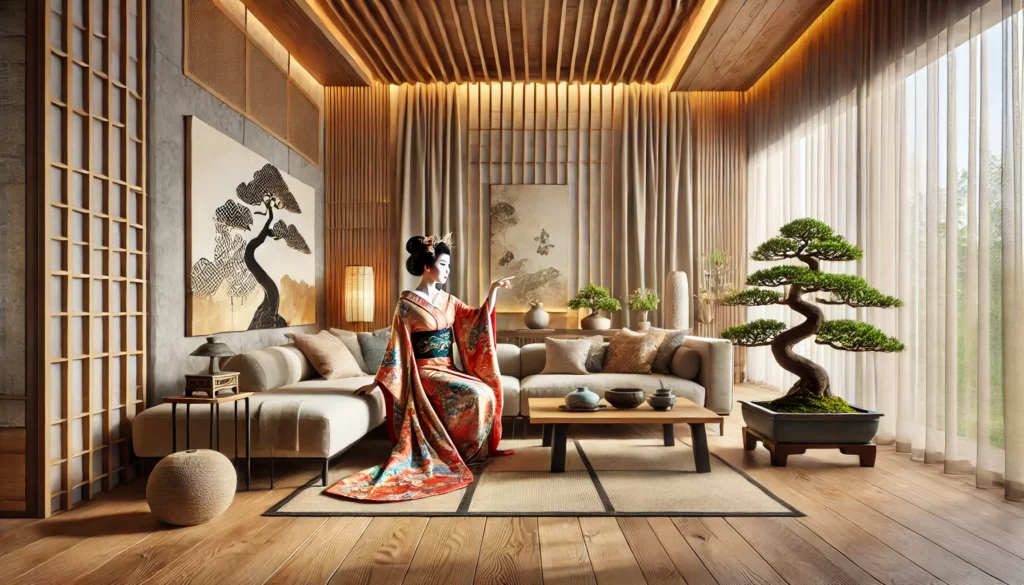The Wabi-Sabi Philosophy in Geisha exemplifies a profound aesthetic and philosophical approach to life that is uniquely Japanese.
It celebrates the beauty in imperfection, impermanence, and authenticity, offering a stark contrast to the modern obsession with perfection and permanence.
Geisha, as cultural icons of Japan, embody this philosophy through their art, appearance, and way of life, creating a harmonious blend of traditional beauty and imperfection.
This article delves deeply into the relationship between Wabi-Sabi and Geisha culture, exploring how this philosophy shapes their identity, performances, and the lessons it imparts to the modern world.
Wabi-Sabi Philosophy in Geisha
What Is Wabi-Sabi?

Wabi-Sabi is a Japanese aesthetic principle that reveres the imperfect, impermanent, and incomplete. The term combines two distinct ideas:
- Wabi: Originally signifying a rustic, solitary lifestyle, Wabi has evolved to reflect simplicity, humility, and harmony with nature.
- Sabi: Meaning the beauty that comes with aging, wear, or patina, Sabi celebrates the passage of time and the stories objects or people carry.
Together, Wabi-Sabi rejects the pursuit of flawless perfection, focusing instead on authenticity, natural cycles, and the understated elegance of imperfection.
In Geisha culture, Wabi-Sabi is not merely an aesthetic choice but a way of life.
From the delicate asymmetry of their performances to the fleeting nature of their appearances, Geisha epitomize Wabi-Sabi’s core values.
Geisha as Living Examples of Wabi-Sabi Philosophy
The Wabi-Sabi Philosophy in Geisha manifests in various aspects of their life and art, creating a profound connection between traditional Japanese aesthetics and cultural heritage.
Below are the key ways Geisha embody this philosophy:
- The Beauty of Imperfect Makeup
A Geisha’s makeup, while meticulously applied, leaves room for subtle imperfections that enhance their natural charm.
The white foundation is not meant to conceal but to contrast their natural features, allowing slight nuances like visible skin texture or a faint smudge to reflect authenticity.
This subtle imperfection aligns perfectly with Wabi-Sabi’s celebration of the natural and unpolished. - Seasonal Elegance in Kimonos
Geisha kimonos are masterpieces of traditional Japanese craftsmanship. However, their true beauty lies in their reflection of nature’s cycles.
Patterns and colors are carefully chosen to match the seasons—cherry blossoms in spring or maple leaves in autumn—emphasizing transience.
Slight fading or hand-stitched repairs on older kimonos are embraced as part of their story, showcasing Wabi-Sabi’s appreciation for impermanence and individuality. - Artful Imperfection in Performances
Geisha performances, whether in dance, music, or tea ceremonies, are never about mechanical precision. Instead, they focus on conveying emotion, subtlety, and presence.
A missed step or a slightly off-note adds a human touch, reflecting the Wabi-Sabi belief that imperfection can enhance, rather than detract from, an experience. - Aging with Grace
In Geisha culture, aging is not seen as a flaw but as a source of wisdom and refinement.
Senior Geisha, known as okiya, are celebrated for their mastery and grace, embodying Wabi-Sabi’s reverence for the beauty of aging.
Their years of experience add depth to their performances, making them even more compelling.
How Wabi-Sabi Shapes Geisha Culture
The Wabi-Sabi Philosophy in Geisha permeates their art and rituals, reflecting a worldview that values simplicity, authenticity, and connection to nature. Here are key elements where Wabi-Sabi plays a defining role:
- Tea Ceremonies
Geisha-led tea ceremonies are a quintessential expression of Wabi-Sabi.
The ceremony incorporates rustic, asymmetrical teapots and cups, which are intentionally imperfect to highlight their natural beauty.
Every gesture, from pouring tea to serving it, is slow and deliberate, drawing attention to the present moment and the imperfect harmony of the setting. - Hair and Accessories
A Geisha’s hairstyle is a labor-intensive process, requiring precision and artistry.
Yet, natural wear over the course of a day—loosened strands or slightly tilted hairpins—are seen as part of their charm.
This imperfection is not corrected but embraced as a reflection of life’s unpredictability. - Natural Surroundings
Geisha often perform in traditional settings such as tea houses or gardens.
These venues are designed with Wabi-Sabi aesthetics in mind—featuring weathered wood, moss-covered stones, and natural light.
These elements create an atmosphere of tranquility and timelessness, enhancing the connection between Geisha and their surroundings.
Lessons from Wabi-Sabi Philosophy in Geisha Culture
The Wabi-Sabi Philosophy in Geisha offers timeless lessons that remain relevant in today’s fast-paced, perfection-driven world.
These lessons encourage us to rethink our definitions of beauty, success, and fulfillment.
- Embrace Imperfection
Geisha culture reminds us that flaws can be sources of strength and beauty.
Whether in art, relationships, or personal growth, embracing imperfection allows us to focus on authenticity rather than superficial ideals. - Live in the Present
The transient nature of Geisha performances and seasonal attire emphasizes the importance of savoring each moment.
This focus on the present aligns with mindfulness practices, which are increasingly popular in modern well-being. - Value Simplicity
By prioritizing simplicity and minimalism, Wabi-Sabi invites us to declutter our lives—both physically and emotionally.
Geisha culture demonstrates that true beauty often lies in what is understated and genuine. - Revere Aging and Time
The respect shown to senior Geisha serves as a reminder to value experience and the beauty that comes with age.
It challenges societal pressures to maintain a youthful facade, advocating instead for grace and wisdom.
Conclusion
The Wabi-Sabi Philosophy in Geisha serves as a powerful reminder of the beauty inherent in imperfection, impermanence, and simplicity.
Geisha, through their art and way of life, embody these principles in ways that inspire and captivate.
From their imperfectly perfect makeup to their seasonal kimonos and graceful aging, Geisha offer a living testament to Wabi-Sabi’s timeless values.
In a world increasingly dominated by artificial perfection, the lessons of Wabi-Sabi encourage us to find beauty in the flawed, cherish the fleeting, and celebrate the authentic.
By embracing these principles, we can cultivate a more meaningful and balanced life—one that values the journey over the destination and the imperfect over the unattainable.
You might like this: Geisha Symbolism: Understanding Colors